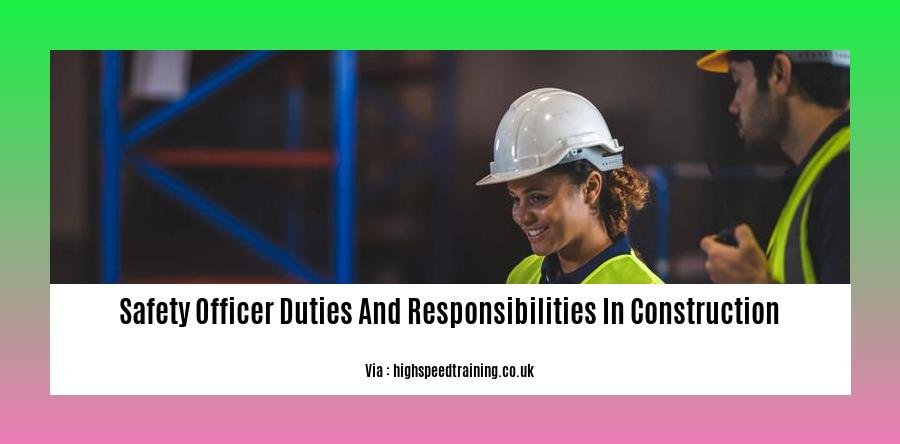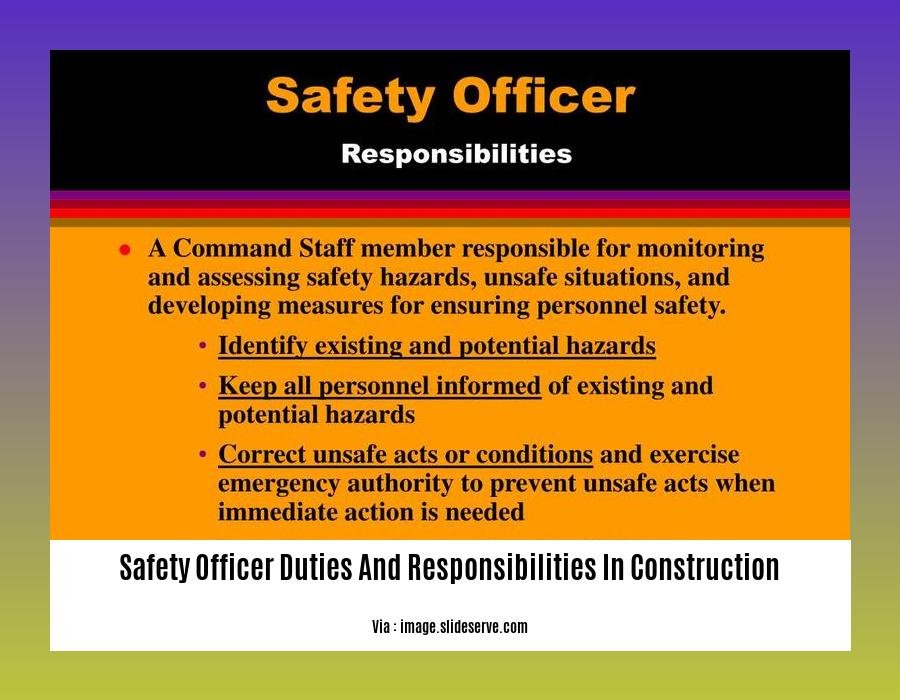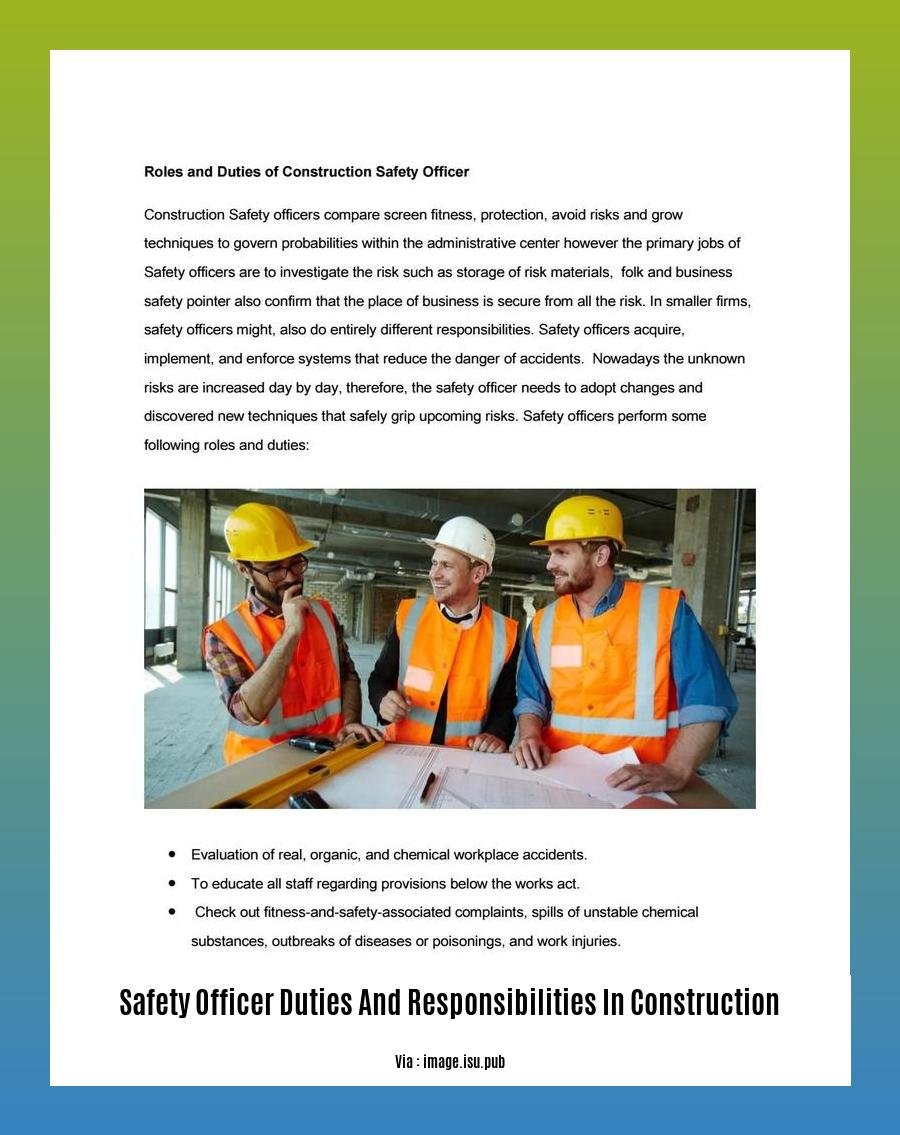Introducing the comprehensive guide to Safety Officer Duties and Responsibilities in Construction! This guide delves into the crucial role of safety officers in ensuring the safety and well-being of individuals on construction sites, minimizing accidents, and promoting compliance with industry standards.
Key Takeaways:
- Assesses and documents hazards and risks.
- Oversees safe temporary work areas.
- Supervises the handling of hazardous materials.
- Monitors hazardous operations in the workplace.
- Investigates accidents and near-misses.
- Establishes and implements safety standards.
- Prepares for emergency responses.
- Ensures worker safety and prevents hazardous situations.
- Addresses employee safety concerns promptly.
- Creates and implements accident prevention procedures.
- Conducts site inspections to identify hazards.
- Inspects equipment and removes defective items.
- Provides training on the safe use of construction tools and equipment.
- Develops policies and procedures to prevent accidents.
Safety Officer Duties and Responsibilities in Construction

As a safety officer in construction, your top priority is ensuring the well-being of workers and preventing accidents. Here’s a comprehensive guide to your crucial duties and responsibilities:
Hazard Management
- Identify and assess hazards: Regularly inspect sites and identify potential hazards that could cause harm to workers or the environment. Conduct risk assessments to evaluate the severity and likelihood of each hazard.
- Develop and implement controls: Create and implement measures to eliminate or minimize hazards. This may include barriers, personal protective equipment, or safe work procedures.
- Provide hazard training: Train workers on how to recognize and avoid hazards, and empower them to report any unsafe conditions.
Accident Prevention
- Investigate accidents and near-misses: Thoroughly investigate any accidents or near-misses to determine the root cause and develop corrective actions to prevent future incidents.
- Implement safety policies and procedures: Establish clear safety policies and procedures, including protocols for handling emergencies, hazardous materials, and equipment safety.
- Monitor compliance: Regularly monitor adherence to safety policies and procedures, and take corrective actions when violations occur.
Site Safety Supervision
- Supervise temporary work areas: Ensure temporary work areas are set up safely, with proper access, lighting, and ventilation.
- Monitor hazardous operations: Supervise hazardous operations, such as working at heights, using heavy machinery, or handling hazardous materials, to ensure proper safety measures are followed.
- Inspect equipment and tools: Regularly inspect tools, equipment, and machinery to identify any defects or hazards, and remove them from service until they are safe to use.
Worker Safety
- Provide safety training: Conduct safety training programs to educate workers on proper work practices, hazard awareness, and emergency procedures.
- Promote safety consciousness: Foster a culture of safety consciousness on-site, encouraging workers to report unsafe conditions and participate in safety initiatives.
- Address safety concerns: Promptly address any safety concerns raised by workers and take appropriate action to rectify the situation.
Stay protected on your construction site by learning about common safety issues and how to mitigate them. Prevent falls and accidents with safety nets specifically designed for construction sites. Enhance workplace observation skills with these valuable safety observation examples. Find the perfect candidate for your safety team with this comprehensive safety officer job description, ensuring a safe and compliant work environment.
Provide Safety Training and Education

As a safety officer, you aren’t merely tracking safety performance — you’re also charged with shaping it. By providing safety training and education, you can transform your team into proactive safety champions.
Steps for Providing Effective Safety Training and Education
-
Identify Training Needs: Assess the safety risks and knowledge gaps within your team.
-
Develop Training Content: Craft training materials that align with the identified needs and regulatory requirements.
-
Facilitate Training Sessions: Conduct engaging training sessions that actively involve participants.
-
Provide On-the-Job Training: Supplement classroom training with practical exercises to reinforce learning.
-
Monitor and Evaluate Training: Regularly assess training effectiveness and make adjustments as needed.
Benefits of Safety Training and Education
- Reduced accidents and injuries
- Improved compliance with safety regulations
- Enhanced productivity
- Increased employee morale
Key Takeaways:
- Invest in comprehensive safety training to equip your team with the knowledge and skills needed to stay safe.
- Tailor training to address specific safety risks and hazards on your site.
- Use a combination of classroom, on-the-job, and online training methods to maximize engagement.
- Regularly evaluate training effectiveness and make adjustments to ensure ongoing improvement in safety performance.
Sources:
- Safety Training for Construction Workers
- Construction Safety Officer Job Description: Salary, Duties, & More
Investigate Accidents and Incidents
As a safety officer, investigating accidents and incidents is paramount to improving safety performance and preventing their recurrence. Here’s a step-by-step guide to effective accident investigation:
1. Preserve the Scene
- Secure the area to prevent further incidents.
- Document the scene with photos, videos, and sketches.
- Interview witnesses immediately to gather fresh accounts.
2. Determine the Root Cause
- Use a systematic approach like the “5 Whys” or “Root Cause Analysis” to identify the underlying causes.
- Consider human factors, environmental conditions, equipment failures, and organizational practices.
3. Develop Corrective Actions
- Based on the root cause analysis, develop specific actions to prevent similar incidents.
- Implement engineering controls, revise work procedures, or enhance training as needed.
4. Communicate Findings and Actions
- Share the investigation findings with all relevant parties, including workers, supervisors, and management.
- Communicate the corrective actions and ensure their implementation.
5. Monitor and Evaluate
- Follow up on the corrective actions to ensure their effectiveness.
- Monitor incident data to track trends and identify areas for improvement.
Key Takeaways:
- Preserving the scene: Protect the area to prevent evidence loss.
- Determining the root cause: Identify the underlying factors that led to the incident.
- Developing corrective actions: Implement measures to prevent recurrence.
- Communicating and sharing: Inform all parties and ensure understanding.
- Monitoring and evaluating: Track progress and make necessary adjustments.
Sources:
- HSE: Investigating Accidents and Incidents
- OSHA: Accident Investigation
*
Maintain Safety Records and Documentation
As a safety officer, maintaining meticulous safety records and documentation is a cornerstone of my responsibilities. These records serve as a vital historical account of all safety-related activities, providing an auditable trail for compliance, investigations, and continuous improvement.
Key Takeaways:
- Documentation ensures accuracy and accountability. Recorded data eliminates inconsistencies and disputes, providing a reliable record of safety performance.
- Records facilitate trend analysis and risk reduction. By tracking incidents, near-misses, and safety audits, we identify patterns and areas for improvement, proactively addressing potential hazards.
- Documentation supports regulatory compliance. Comprehensive records demonstrate adherence to industry standards and legal requirements, minimizing liability and maintaining a positive safety culture.
Establishing a Robust Recordkeeping System
- Identify essential documents: Determine the types of records required by regulations and best practices, including inspection reports, incident investigations, training logs, and risk assessments.
- Establish a filing system: Create a logical and accessible organizational structure for storing records both physically and electronically.
- Standardize data entry: Develop templates and guidelines to ensure consistency and accuracy in recording information across the team.
- Implement retention policies: Establish timelines for retaining records based on legal requirements and practical considerations.
Best Practices for Documentation
- Be thorough and detailed: Capture all relevant information, including dates, times, witnesses, and corrective actions taken.
- State facts objectively: Avoid subjective opinions or assumptions.
- Use clear and concise language: Ensure documentation is easily understood by all readers.
- Review and update regularly: Keep records up-to-date and reflect any changes in safety protocols or regulations.
Benefits of Effective Recordkeeping
- Reduced incidents and accidents: Analysis of safety records helps identify areas of concern and implement preventive measures.
- Improved risk management: Comprehensive documentation supports informed decision-making, enabling proactive risk assessments and mitigation strategies.
- Enhanced credibility and reputation: Well-maintained records demonstrate a commitment to safety and contribute to a positive public perception of the organization.
Sources:
- Construction Safety Association of Ontario: Maintaining Safety Records and Documentation
- Occupational Safety and Health Administration: Recordkeeping
FAQ
Q1: What are the primary duties and responsibilities of a Construction Safety Officer?
Q2: How do Safety Officers contribute to hazard identification and mitigation in construction?
Q3: What role do Safety Officers play in accident prevention and investigation?
Q4: How do Safety Officers promote safety awareness and training on construction sites?
Q5: What are the key elements of a comprehensive Safety Management System implemented by Safety Officers in construction?
- Small Corner Kitchen Ideas: Maximize Style In Tight Spaces - January 1, 2026
- Kitchen Counter Corner Ideas: Style Your Awkward Angles Now - December 31, 2025
- Best Finish for Butcher Block Countertops: Choosing the Right Option - December 30, 2025










